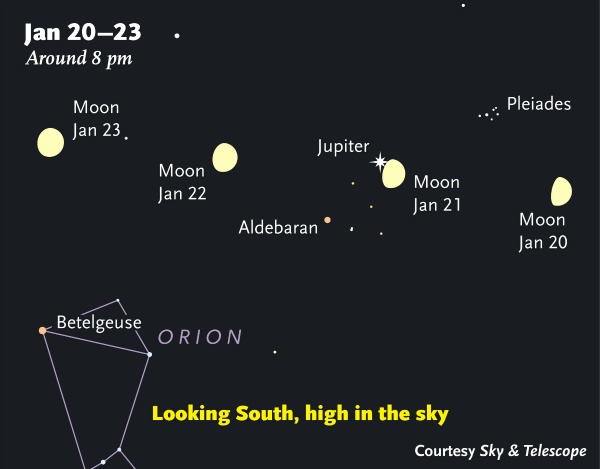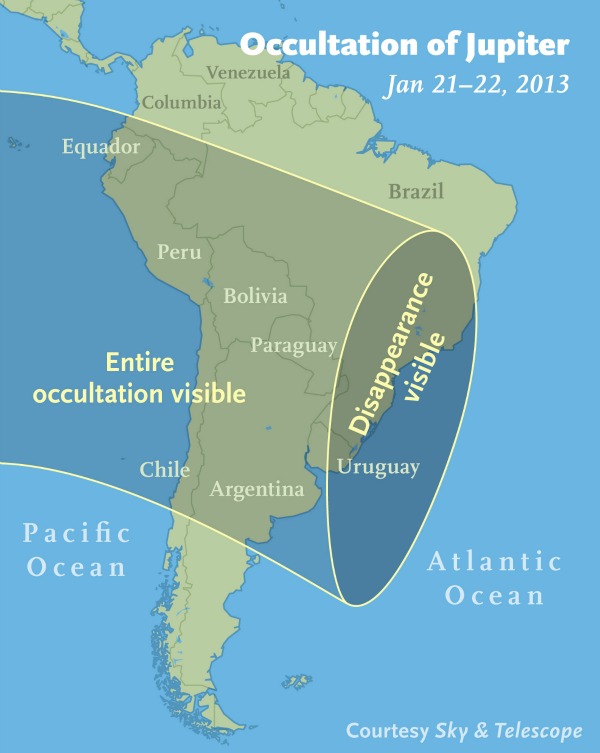Watch Jupiter “Kiss” the Moon Tonight
Tonight, night sky watchers in the Northern Hemisphere can see Jupiter pass less than a finger’s width away from the waxing Moon

Jupiter, which is now close to the Moon in the night sky, will be less than a finger’s width from the Moon tonight.
Over the weekend, the Sun moved into the constellation Aquarius, blocking it from view in the night sky. Although the “Age of Aquarius” of popular culture is far off, tonight some Western Hemisphere observers will get a little bit of astronomical free love as the Jupiter–the second brightest planet in the night sky (the brightest being Venus)–kisses the Moon.
To sky watchers in most of North America, the planet and the Moon will flirt: Jupiter will be less than a finger’s width from the waxing Gibbous Moon. The time of their closest approach varies by location–observers on the East coast will see it at around 11:30 p.m. Central time stargazers should look up at around 10:00 p.m., while those in Mountain time will see Jupiter’s nearest approach to the Moon at about 8:30 p.m. Pacific time observers will catch their best view early in the evening, at roughly 7:00 p.m. The close approach can be best seen with a wide-field telescope at low magnifications (40x or lower) or binoculars, but can even be viewed with the naked eye.
From much of South America, the planet will appear touch the Moon; in some regions, the Moon will completely hide Jupiter from view. This game of hide-and-go-seek, termed occultation, will cause Jupiter to disappear and reappear from the skies over much of central South America. However, when viewed from much of the east coast of Brazil and Uruguay, the Moon will set before Jupiter reemerges.

In some parts of South America, shaded above, the Moon will hide Jupiter from view. Observers in the oval region will see Jupiter disappear, but will not see its reappearance, as the Moon will set before the planet reemerges.
For the past few days, Jupiter has been close to the Moon at sunset, but today, careful observers may even be able to spot Jupiter in the late afternoon, before the Sun sets. “First locate the Moon medium-high in the east; then look a few Moon-widths left or lower left of the Moon for Jupiter,” explained Tony Flanders, associate editor at Sky & Telescope magazine. “It should be easy to spot with binoculars if the air is clear,” he said in a statement.
Those with telescopes can even see Jupiter’s Great Red Spot between 9:00 p.m. and 10:40 p.m. EST today. In addition, Jupiter’s moon Europa will pass in front of Jupiter between 8:13 and 10:37 p.m. EST, although the moon’s shadow–which crosses Jupiter from 10:22 p.m. to 12:46 a.m. will be easier to spot. Have fun planet-watching!
/https://tf-cmsv2-smithsonianmag-media.s3.amazonaws.com/accounts/headshot/mohi-kumar-240.jpg)
/https://tf-cmsv2-smithsonianmag-media.s3.amazonaws.com/accounts/headshot/mohi-kumar-240.jpg)